 |
Summary scores for each characteristic were computed for all sites that had adequate data. Scores for each site in the Nevada Basin and Range Study Unit were compared with scores for all sites sampled in the 20 NAWQA Study Units during 1992-95. Results are summarized by percentiles; higher percentile values generally indicate poorer quality compared with other NAWQA sites. Water-quality conditions at each site also are compared to established criteria for protection of aquatic life. Applicable criteria are limited to nutrients and pesticides in water, and semivolatile organic compounds, organochlorine pesticides and PCBs in sediment. (Methods used to compute rankings and evaluate aquatic-life criteria are described by Gilliom and others [58].) |
| Nutrients Were Higher Than the National Median in Las Vegas Wash
but Were Lower in the Carson and Truckee Rivers
Nutrient concentrations in surface-water samples from two sites on Las Vegas Wash were greater than the national 75th percentile. The flow at the upstream site is primarily from urban drainage. The downstream site, which receives urban drainage and discharge of tertiary-treated sewage, had a nutrient concentration above the national 99th percentile. All NAWQA samples from this site exceeded the aquatic-life criterion for un-ionized ammonia [29]. However, more recent measurements by other agencies during 1996-97 (Steven W. Miller, City of Las Vegas, written commun., 1998) indicate that un-ionized ammonia concentrations are now below the aquatic-life criteria because of full implementation of tertiary treatment. |
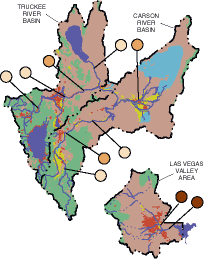 |
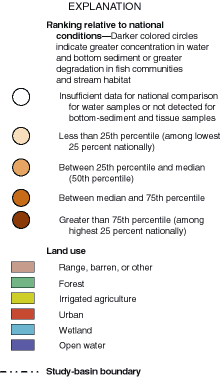 |
Nutrient concentrations in surface-water samples from all sites in the Carson and Truckee River Basins were below the national median. Five of the eight sites had nutrient concentrations below the national 25th percentile. Two of those five, which are in forested headwater areas, had nutrient concentrations below the national 10th percentile. Two sites on the Carson River downstream from agricultural areas in Carson Valley and Carson Desert had nutrient concentrations between the national 25th percentile and median--- higher than the concentrations at sites in the forested headwater areas. Nutrient concentrations at one site on the Truckee River, several miles downstream from the discharge of tertiary-treated sewage effluent from the Reno-Sparks urban area, were the highest measured on the Truckee River, but were less than the national median.
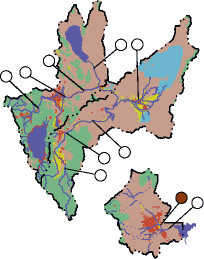 |
Pesticides in Las Vegas Wash Were Greater Than the National 75th
Percentile
Pesticides were commonly detected in water samples from Las Vegas Wash. The Las Vegas Wash site is downstream from most of the urban area, thus, most flow at the site is urban drainage. It is upstream from the discharge of tertiary-treated sewage. Pesticide concentrations at this site were greater than the national 75th percentile. Diazinon and malathion concentrations exceeded aquatic-life criteria [32,33] in 47 and 25 percent of the samples from this site, respectively. Las Vegas Wash transports these pesticides to Las Vegas Bay of Lake Mead, which is a National Recreation Area administered by the National Park Service. Although water samples for pesticide analyses were collected at additional sites in Las Vegas Valley and in the Carson and Truckee River Basins [31], the number of samples and duration of sampling were insufficient for national comparisons [58]. |
| Trace Elements in Bottom Sediment Downstream From Mineral
Deposits, Historical Mining Activities, and Urban Areas Were Greater Than
the National Median
Trace elements (arsenic, cadmium, chromium, copper, lead, mercury, nickel, selenium, and zinc) were greater than the national median in bottom sediment at some sites in the Study Unit. Trace-element concentrations in bottom sediment at two sites downstream from the Las Vegas urban area, Las Vegas Wash and Las Vegas Bay in Lake Mead, were between the national median and 75th percentile. These sites are affected by urban drainage and sewage effluent. Trace-element concentrations, particularly arsenic and mercury, in the bottom sediment at all sites in the Carson River Basin were greater than the national median. Mercury was present in the upstream forested headwater site of the East Fork Carson River because of naturally occurring mercury ore (cinnabar) [53]. This area is within one of three regions, worldwide, with economically extractable deposits of mercury ore [57]. Arsenic and mercury were much higher at the downstream site on the East Fork Carson River and the three sites on the Carson River, all of which are downstream from historical mining areas. Concentrations at these four sites exceeded the national 75th percentile. |
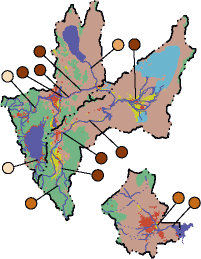 |
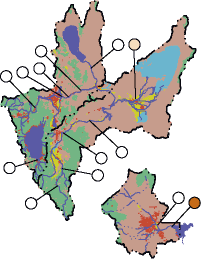 |
Organochlorine Pesticides and Polychlorinated Biphenyls (PCBs) Were
Not Detected at 11 of 13 Sampled Sites
Concentrations of organochlorine pesticides and PCBs were not detected at 11 of the 13 sites where those compounds were analyzed in bottom sediment and clam tissue. Three degradation products of DDT were detected in Las Vegas Bay of Lake Mead, which receives urban drainage and sewage effluent from the Las Vegas urban area. The concentrations at that site were between the national median and 75th percentile. A degradation product of DDT was detected at one site in the lower Carson River [31], downstream from agricultural activities in Carson Desert; the concentration was less than the national 25th percentile. |
| Semivolatile Organic Compounds (SVOCs) in Bottom Sediment
Downstream From Urban Areas Were Greater Than the National 75th Percentile
In the three study basins, 8 of 13 sites had bottom-sediment concentrations of semivolatile organic compounds (SVOCs) that were greater than the national median. The concentrations of SVOCs at two sites downstream from the Las Vegas urban area were greater than the national 75th percentile. Streamflow at the upstream site is primarily urban drainage. The downstream site is affected by the discharge of treated sewage as well. Two sites in the Carson River Basin had concentrations of SVOCs between the national median and 75th percentile. Both sites are downstream from small cities and agricultural areas. Three sites in the Truckee River Basin had SVOC concentrations in bottom sediment that were greater than the national 75th percentile. These sites are downstream from the Reno-Sparks urban area. The upstream site is affected by urban drainage and the two downstream sites are affected by urban drainage and treated sewage effluent. Three of four sites in forested headwater areas of the Carson and Truckee River Basins had concentrations that were less than the national median. |
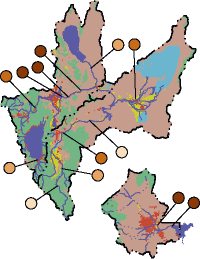 |
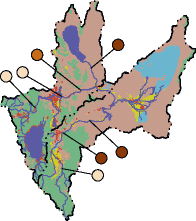 |
Fish Communities in Lower Reaches of the Carson and Truckee Rivers
Were More Degraded Than the National Median
The degradation indices for fish communities were based on the number of non-native and omnivorous fish, the number of fish tolerant to human disturbance, and the number of fish with external parasites or lesions. Fish communities were not evaluated in Las Vegas Wash because it was primarily a conduit for urban drainage and tertiary-treated sewage effluent. However, a study of endocrine systems of common carp by the NVBR NAWQA, National Park Service, and U.S. Fish and Wildlife Service in 1995 showed evidence of endocrine disruption in Las Vegas Wash and Las Vegas Bay of Lake Mead as compared to Callville Bay, an upstream background site in Lake Mead [42]. Evidence of endocrine disruption included high levels of a male sex hormone in female carp from Las Vegas Wash, low levels of a male sex hormone in male carp from Las Vegas Bay, and the presence of an egg protein, which should be found only in females, in high percentages of male carp from Las Vegas Wash and Bay. Synthetic organic compounds detected in the water column, bottom sediment, and carp tissue from Las Vegas Wash and Bay have been shown to cause these effects in previous investigations of other areas [42]. |
| Stream Habitat at All Sites on Carson and Truckee River Systems
Was Better Than the National Median
Stream-habitat degradation was evaluated at seven sites in the Study Unit. The indices of stream habitat for all seven sites were less than the national median, indicating they were less degraded. Habitat-degradation indices were based on riparian vegetation, stream modification, bank stability, and bank erosion. Stream habitat was not evaluated in Las Vegas Valley because most streams there have been channelized, leveed, or otherwise altered in some way and probably differ greatly from their pre-urban character. The indices for four sites, two each in the Carson and the Truckee River Basins, were less than the national 25th percentile, indicating little or no habitat degradation. Of those four sites, one site in each basin is in a forested headwater area. All four sites had the following attributes in common: located in the middle to upper parts of the basin, little or no streambank erosion, streambanks highly stable with either dense stands of vegetation or broad areas of embedded boulders and cobbles. Habitat indices for the remaining three sites (one on the Carson River and two on the Truckee River) were between the national 25th percentile and median. The stream habitats at these three sites had the following attributes in common: located in the lower parts of the basin, low to moderate streambank erosion, moderately stable streambanks with moderate vegetation density, and some areas of embedded boulders and cobbles. |
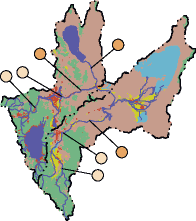 |
| CONCLUSIONS |
Compared to other NAWQA Study Units:
|

Wetlands in Carson Valley, November 1993.
Photograph by Michael S. Lico, U.S. Geological Survey.